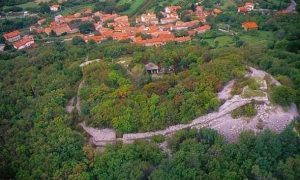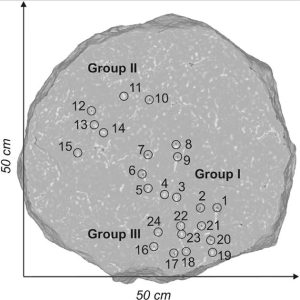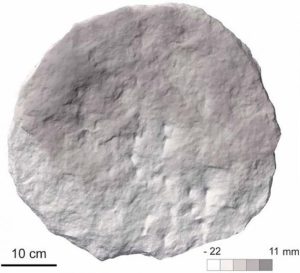Is This a True Example of “The Selection Effect” or an Old Celestial Map?

A pair of researchers report they have identified an ancient celestial map carved on a circular stone at an Italian Bronze Age hillfort. But having taken several leaps of faith, and lacking a probability study, is their claim perhaps a side result of “the selection effect”?
Relic From a Really Ancient Hillfort
Rupinpiccolo, is a village in the Italian province of Trieste, in the region of Friuli-Venezia Giulia. Overlooking this settlement, Rupinpiccolo Castle is a fortified hillfort dating back to the Middle Bronze Age (1800 to 1650 BC). Archaeology shows the hilltop was occupied continually until the Iron Age, and that the defensive site functioned until the 5th century AD, at which time it was abandoned.
The Italian National Institute of Astrophysics (INAF), recently announced the discovery of two large circular stones at the hillfort entrance. Measuring 50 centimeters (19.68 in) in diameter, according to Paolo Molaro from INAF, and researchers from the Ca’ Foscari University of Venice and ICTP, one of the stones “is a representation of the sun, while the other is a carved celestial map dated to the 4th century BC”.
Delineating the Alleged Ancient Celestial Map
A new research paper has been published in the German astronomy magazine “ Astronomische Nachrichten,” in which the two authors present an alleged celestial map which they claim depicts the sky above Rupinpiccolo as seen around 2,500-years-ago. They claim their discovery represents “the oldest known celestial map” ever found in Italy.
29 individual engravings were identified, or “selected,” on the face of one of the stones which the researchers say “correspond precisely to the constellations of Scorpius, Orion, the Pleiades and Cassiopeia.” The researchers struggled to identify a specific star carved on the stone which they suspected was Theta Scorpii, and using astronomy software they found it is now out of sight at Castelliere di Rupinpiccolo, but that it was observable from the ancient hillfort around 400 BC.

A Bronze Age Rock Has Become a ‘Treasure Map’ for Researchers
Visoko: An Astronomical Map of More than 100,000 Years
Aerial view of Castelliere di Rupinpiccolo. (Carta Archaeologia Online)
Popping In a Supernova to Plug a Gap?
The two researchers mulled over the so-called “29th engraving” which couldn’t be correlated with celestial software. Instead of questioning the validity of their theory, the astronomer Alessandro Bressan doubled down suggesting it was a star in the Orion cluster that was present at the time the stone was carved, but that later exploded as “a supernova.” From here, the researchers claim their work might “potentially reveal a black hole,” caused by the supernova explosion.

The frontal aspect of the stone disk sourced from a modification of figure 1 of Bernardini et al. (2022). A curvature map of the disk, highlighting the locations of chisel marks denoted by black circles and corresponding numbers. (Paolo Molaro, Federico Bernardini/Wiley Online Library)
Having matched the circular stone against star constellations, based on the angle of the cut marks, the researchers suggest that the star map was created with hammer and metal chisel, “with a 6-7 mm tip”. But while this story is spellbinding, nuanced and saturated in math, you should know that the depth of the chisel is the only aspect of this discovery that is actually measurable, and the rest can be argued until the cows come home.

Digital elevation mode of the primary face (featuring 24 engravings) of the stone examined in the study. (Bernardini et al., Documenta Praehistorica, 2022/INAF)
Real Science, Or Pie in the Sky?
With all due respect to the researchers, this story has echoes of the 15-year-old Canadian boy who, in 2016, leading scientists claimed “had discovered a previously undiscovered Maya city using astronomy software.” William Gadoury “thought” he’d found an abandoned Maya city deep in the heart of Mexico’s Yucatan Peninsula, but after the media fandango passed, National Geographic explained how this was all “a very western mistake”.
Professor Anthony Aveni, the so-called father of archaeoastronomy, said “trying to impose a one-to-one correspondence between a modern star map and a large number of ancient man-made features, whether it’s Maya cities or the Nazca Lines, “is simply an act of creative imagination.”
David Stuart, an anthropologist from The Mesoamerica Center-University of Texas at Austin, wrote on Facebook, regarding the Maya city ‘find’, that “the whole thing is a mess – a terrible example of junk science hitting the internet in free-fall.”
A Complex Star Map, Or Just the Moon
Returning to the circular stone discovered in Italy, while the researchers present what looks to be a strong argument, perhaps the eminent astrophysicist Professor Gulio Magli, who teaches the first official course in archaeoastronomy at the Polytechnic University of Milan, would point towards “the selection effect.” This is when researchers start out with an assumption, then select data to support it, dropping or burying any contradictory evidence.
The proposed sky map “is missing the stars Bellatrix and Saiph.” Furthermore, to identify the problematic anonymous star, astrophysicists would have to identify the cosmic remains of a failed supernova to the North of Betelgeuse that occurred in the position of the unidentified mark.
Covering their academic reputations, in the very last line of the new study, the authors admit that their interpretation is only “a suggestion,” and they urge additional studies “to avoid fanciful interpretations.”
For sceptics, the simplest astronomical interpretation is that the smooth circular stone represents the Sun, and the pitted stone represents the scarred moon as seen from Earth, a theory that needs no supernova, black hole, or any other cosmic catastrophe to stand up, but also, remains a theory.